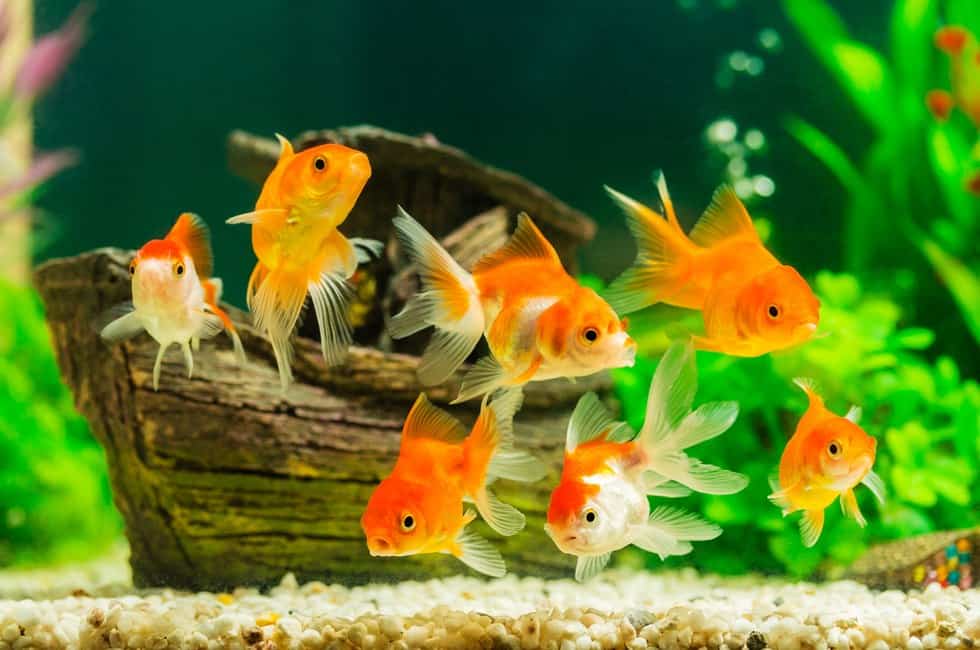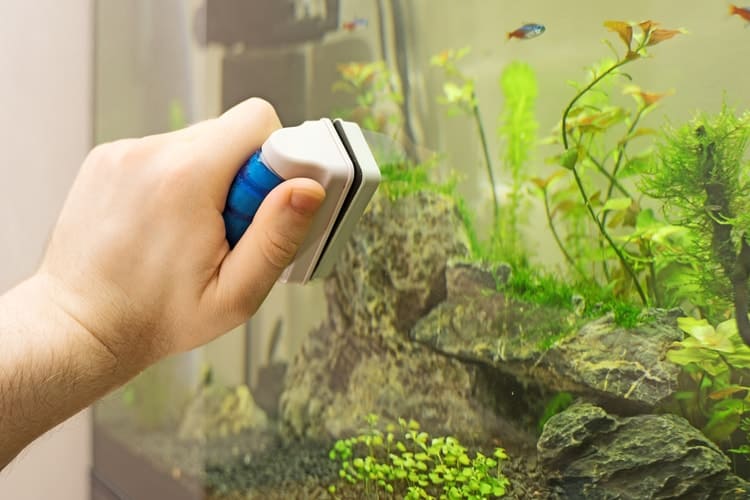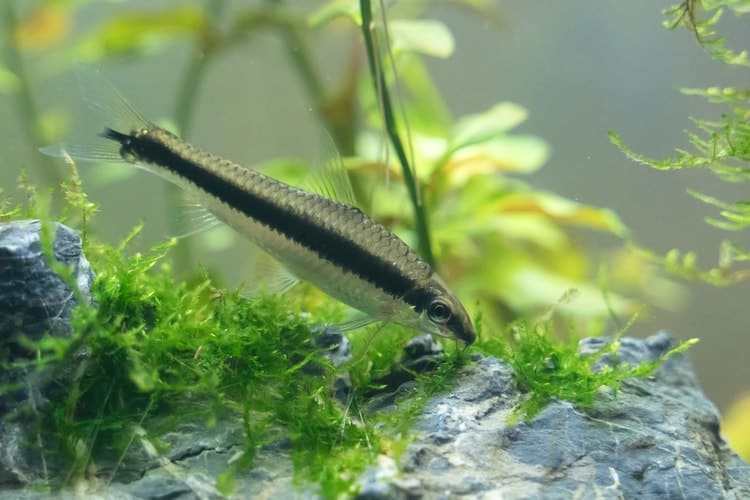As the proud owner of a fish tank, you must have fought off Algal infection at one point or the other. If you have then you understand why they are every fish owner’s bane.
They muck up the tank and are almost impossible to get rid of without harming the plants and fishes that call your tank their homes. Luckily, we have done extensive research and discovered several ways to rescue your tank from algae without harming the plants or fishes.
At this point, you are probably wondering just how getting rid of them naturally is possible. Most times when dealing with Algae, Algaecide has been the best way to go.
It’s effective, strong and causes minimal damage; it’s a reasonable compromise – or at least that what the commercials say. We, however, think that isn’t good enough.
So, How do you Get Rid of Algae Naturally?
Well, it’s a combination of a lot of things. Truthfully, they might eventually rack up the overall bill for upkeep but most of these Algae elimination methods are relatively manageable and mostly inexpensive.
The secret to eliminating Algae naturally can be summed up to taking better care of your fish tank.
This means using filtered water and not tap water, changing a substantial percentage of the tank’s water every week, removing fish waste, introducing natural Algae-eating sea life into the tank, starving the algae by introducing competition, controlling exposure to light and regulating carbon dioxide levels in your tank.
All these potential solutions are not particularly effective alone, they have to be coupled with a few others to become potent enough to deter and eliminate algal growth.
The essential principle behind all these potential solutions is to make the tank less conducive for all kinds of Algal life. For example, constantly changing the tank’s water will make the tankless conducive to blue-green algae and other types of algae.
The solution before you might look like an extensive checklist but in reality, it just covers most of the basic rules of being a responsible pet owner. There are so much more to taking care of marine life but I think we should just settle for the eradication of Algae for now.
While we are on the topic, let’s take a closer look at algae and why we are going through so much trouble to get rid of them. If you have little experience with marine life, then by now you probably assume that Algae is dangerous and probably poisonous. Well, in their own way they are.
What are Algae and are they really dangerous
Algae are a group of photosynthetic, polyphyletic, and aquatic organisms. There are over 30,000 types of algae present in the world today and scientists estimate that there could be as much as a million species out there.
Algae are rarely poisonous and they generally thrive in the most aquatic environment. All they need are water, sunlight and some essential nutrients- all of which are more than abundant in your aquarium.
Although there are over 130,000 types of known algae, only a handful manifest themselves in your local aquarium. Luckily, those few are not dangerous or poisonous [in most cases].
Honestly, most people get rid of them because they are the exact opposite of what they had planned when they went to the store and picked out a tank.
Algae are not dangerous unless they are left unchecked.
Algae get dangerous when they are not kept in check. Some Algae like the red algae have actually been known to have some aesthetic appeal to most aquarium hobbyist.
However, algae like the brown or the blue-green can cover the aquarium walls, clog filters, grow on everything and block sunlight when left unchecked.
Causes of algal bloom
Algae is incredibly difficult to handle, they appear almost spontaneously after an Algal bloom and just take over. An algal bloom is the spontaneous growth of Algae.
Usually, algae are present in small quantities in most fish tank- hence the hobbyist remark from earlier, and when they are met with the right conditions they bloom explosively and that is when they become a problem.
The right conditions would mean the presence of certain nutrients and a light source. These nutrients are usually phosphates, silicates, nitrates and sometimes ammonia.
Basically, they thrive off of any major chemical imbalance in the ecosystem of the tank. Too much of anything can cause the spark that ignites their sporadic growth.
Types of Algae and What Causes Them
These are a few of the most prominent and reoccurring species of algae in fish tanks. Although they are all caused by different factors, it can all be traced back to an imbalance in the chemistry of the tank or poor maintenance.
Blue-green Algae: They are one of the few algae that Algae eaters or scavengers don’t touch. They are slimy, and often poisonous when left unchecked.
They thrive in excess light, poor water circulation, poor oxygen levels, and high nitrate levels- they essentially thrive in a poorly maintained aquarium.
Green Algae: They grow on basically anything- even the fish and are one of the most unforgiving Algae out there. They bloom when there is a sudden spike in a particular element in your tank. It could be a sudden exposure to sunlight, or missing a water changing cycle, or sudden overfeeding, etc.
Brown Algae: They usually appear on the glasses and gravel of the aquarium. They are furry to the touch and they are caused by excess nitrates, silicates, improper lighting, and low oxygen.
Red Algae: Although aesthetically appealing, it can be quite distasteful when allowed to run amuck. It is thread-like and thrives in environments with low co2 and excess nutrients.
Preventing and Eradicating Algae
Algae are mostly self-replicating organisms that develop at a sporadic rate. Only algaecide and well-maintained tank can fight them off. Since the former is not an option, let us explore the latter.
1. Regulate the oxygen and co2 levels in your tank
A lot of Algae thrive on poor co2 levels and oxygen levels and it’s not the algae mentioned above. Although Algae can thrive at almost any level of co2, it will be better to check this off the list.
A properly oxygenated tank can go a long way in limiting the growth of algae and that is why you should consider getting some plants to liven up your aquarium and invest in an aeration system.
This will raise the carbon dioxide levels and help you get one step closer to an algae-free tank. If this seems a little bit confusing, go to your local pet store and ask around- any decent store clerk will break it down to you and set you up with what you need.
2. Review your fish feeding habits
I know you might be passionate about fish- a lot of hobbyists really are, but you need to limit just how much love you show the little guys. Feeding them too much might just do more harm than good to all parties involves.
Like I said, blue-green algae and all other algae for that matter thrive off of excess nutrients in the water. Excess fish feeds just ramp up ammonia and phosphate levels of most tanks and help algae grow faster.
You should try to figure out if you are overfeeding your fishes. Usually, floating leftover feeds are an indication of that. You should probably reduce the quantity of feed you give them to the quantity they can consume instantaneously.
If this doesn’t work for you, try increasing the frequency of feed times to two and if you have a fish that require a little more, feed accordingly.
It would be advisable to invest in an automatic feeder and just forgo the whole fear of overfeeding thing. This part of the steps should not be overlooked.
Most algae depend and thrive off the extra nutrients that feed injects into the water. Reducing the feed is essentially cutting off their food source.
Directly removing excess feed is not a bad idea too. Just get a little net and scoop up all the excess feed in the water. You’ll be getting rid of the problem before it even starts.
3. Regulate light exposure to limit green and brown algae growth
This step is somewhat sensitive. Light is good for the plant life in your aquarium, but it’s also great for the algae too since they are photosynthetic plants.
So, maybe the solution is just starving the plant life and just getting rid of all the algae along with the plants. However, that plan is flawed because brown algae thrive algae thrives in the dark.
The only solution that wouldn’t let the Algae win is regulated exposure to sunlight. This can be achieved by shaded exposure to sunlight. This will give the plants in your just enough to get by and starve the algae at the same time.
Even though the exposure to sunlight is shaded, it shouldn’t last for more than 6-10 hours per day, any more will put your fishes at a disadvantage. Algae also thrive in the heat, so you should try to move your tank- if it’s not too large- to a cool room.
4. Introduce some competition into the mix
In a tank with no plant life, algae have full control. They have no competition and will subsequently go unchecked. When you stock your aquarium with plants that compete with the algae for nutrients, you are essentially starving them.
The more plants you have, the lower the chances of algae blooming in the first place. There are a lot of plants to choose from when you are looking to spruce your aquarium up. Some of them include; Crypt Wendtii, Water Wisteria, Hornwort, Dwarf Lilies, etc.
When adding plants to your aquarium, you should note that most plants don’t do well in highly filtered tanks, so try to ease up on the filter a bit.
Try to pay attention to the algal level as you add plants to the tank. It’s important to keep adding more plants until you’re comfortable with the Algal level.
5. Scheduled Water Change
The blue-green algae particularly love water that is poorly looked after. They love excess nitrate and all the other nutrients, they also love the nutrients injected into the water whenever the fish releases waste.
A scheduled water change, preferably bi-weekly will cut the blue-green algae and other forms of algae off from the excess nutrients floating around in the tank.
There is a flipside, however. Brown algae and other forms of Algae have been known to thrive in aquariums with low bacteria counts. They grow in tanks that are young and imbalanced.
So, when changing the water, try to make sure you don’t change more than 20% every week. Any more and you might be at risk of another algal bloom. Ideally, the quantity you want you to change to be within 10 to 15%.
If your aquarium is salt water then you should add sea salt to the new water before pouring it into the aquarium. Usually, 118 grams of sea salt, which is roughly half a cup of salt should be enough for a gallon of water [3.8 L].
More: How to Clean a Betta Fish Tank
6. Take care of the filter and never use tap water
Aquarium filters are designed to do exactly what you’d expect. They filter the water and get rid of some of the unwanted waste that floats around in the tank. But for an aquarium filter to function properly, it needs its sponge to be spick and span.
This means that along with a scheduled algal scrub down, the filter sponge has to be cleaned every month or so to prevent blockage. Usually, the cleaning process is not all that complicated.
All you need is some aquarium water and a filter sponge. It’s important to clear the gunk and clean the sponge in aquarium water because using tap water will kill some of the bacteria that fight off the toxins that find their way into the tank as time goes on.
When changing the aquarium’s water, you should try to make sure you never opt for tap water. It’s not because it’s harmful to the fishes, it’s just that it typically contains high levels of phosphate and nitrates and last time I checked, those are some of the essential nutrients that algae need.
Always opt for filtered water. It’s more regulated and chemically balanced and it retains some of the toxins fighting bacteria that the ecosystem of the aquarium already contains.
7. A good old-fashioned scrub down
This might be the most important part of your war against algae. A good old-fashioned scrub down entails everything from your filter cleaning, to the gravel scrapping and even decorations cleaning.
Although most times it’s one of the fastest ways to get rid of most of the algae, it sometimes can be a bad idea. For example, green dust Algae plagues tanks with an imbalance of CO2 and nutrients and in most cases actually scrubbing it off does more harm than good.
Amongst some aquarium hobbyist, they have found out that scrubbing or removing it would just cause it to release spores and, in a few days, you’ll be back to square one.
They have advised that simply leaving the algae to run its full course is probably the most effective way to be done with it permanently. Anyways, that is just one algae species. The rest respond well to a good scrubbing and starving.
For the scrub down, I would advise you to get an acrylic friendly algae pad, a plastic blade for your acrylic tank, a gravel scrapper, a siphon and an aquarium bucket.
Make sure you get all the algae off every item in the tank [glass included]. Take your time and clean the gravel and the items, even the plants too. When you are sure that it’s all gone siphon off all the debris and put the aquarium back together again.
8. Getting a little help
There are several invertebrates and fishes that feed on algae. Some of them actually prefer it. Although they don’t eat all species of algae, it can help to have some shrimps and fishes to help keep the algae in check.
These little guys are sometimes called scavengers or natural algae removers but regardless of how effective they are, they can sometimes be more of a problem than a solution.
Getting the right scavenger sometimes can be a tradeoff, some of them are aggressive as they become more mature and subsequently have to be removed from the tank for the other fishes’ safety.
And like I said earlier some prefer certain algae, so you can’t just buy the first scavenger you see. Getting a little bit of everything might be the best option.
Some recommended scavengers are the bushy-nosed pleco, the mystery snail, Siamese Algae eater, twig fish, cherry shrimp, and Amani shrimp.
Obviously, there are a lot of other options out there and they are mostly all safe but some research is recommended. You should buy the scavenger that feeds on the most reoccurring type of algae prevalent in your aquarium.
Tips and facts
- There are often times more than one type of algae currently residing in your tank. Always focus on the most prevalent. In most cases, the others usually die out eventually.
- Try not to use bleach if you can, it’s super harmful to the fishes and most times not worth the risk. If you, however, decide to go with bleach, try to keep it at a bare minimum.
- Never, ever use soap. It is a bad idea, don’t do it.
- Know the type of fish tank you got and but cleaning supplies accordingly. For example, acrylic pads for acrylic tanks.
Are scavengers enough?
They are not. Although they are quite effective, they can sometimes contribute to the imbalance of the tank’s ecosystem.
Properly looking after the tank by following what was covered in this article coupled with scavengers are one of the effective ways to get rid of algae permanently.
Are there more algae that I need to worry about aside from the one covered in this article?
Yes, there are at least a handful of other algae that spring up in household aquarium. They should be fairly easy to deal with but if they prove difficult research is recommended.




